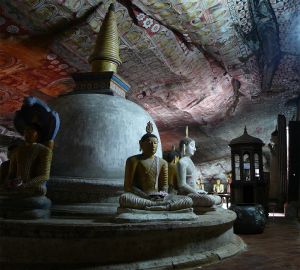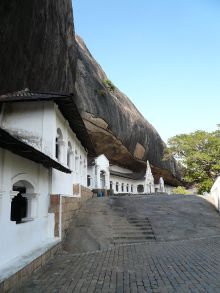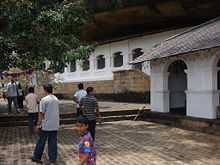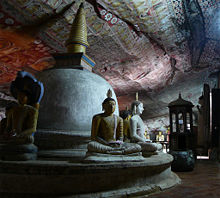Difference between revisions of "Dambulla cave temple" - New World Encyclopedia
Dan Davies (talk | contribs) (images OK) |
Dan Davies (talk | contribs) (formating, integrating inserted article) |
||
| Line 1: | Line 1: | ||
{{images OK}} | {{images OK}} | ||
| + | {{coor title dm|7|51|24|N|80|38|57|E|type:world heritage site }} | ||
{{Infobox World Heritage Site | {{Infobox World Heritage Site | ||
|Name = Golden Temple of Dambulla | |Name = Golden Temple of Dambulla | ||
| Line 14: | Line 15: | ||
'''Dambulla''' Cave Temple (also known as the Golden Temple of Dambulla) is a world heritage site (1991) in [[Sri Lanka]], situated in the central part of the country. This site is situated 148 km east of [[Colombo]] and 72 km north of [[Kandy]]. It is the largest and best-preserved cave temple complex in Sri Lanka. The rock towers 160 m over the surrounding plains.There are more than 80 documented [[caves]] in the surrounding. Major attractions are spread over 5 caves, which contain [[statues]] and [[paintings]]. This paintings and statues are related to Lord [[Gautama Buddha|Buddha]] and his life. There are total of 153 Buddha statues, 3 statues of Sri Lankan kings and 4 statues of gods and goddesses. The later 4 include two statues of [[Hindu]] gods, god Vishnu and god Ganesh. The murals, covers an area of 2,100 square meters. Depictions on the walls of the caves include Buddha's temptation by Mara (demon) and Buddha's first [[sermon]]. | '''Dambulla''' Cave Temple (also known as the Golden Temple of Dambulla) is a world heritage site (1991) in [[Sri Lanka]], situated in the central part of the country. This site is situated 148 km east of [[Colombo]] and 72 km north of [[Kandy]]. It is the largest and best-preserved cave temple complex in Sri Lanka. The rock towers 160 m over the surrounding plains.There are more than 80 documented [[caves]] in the surrounding. Major attractions are spread over 5 caves, which contain [[statues]] and [[paintings]]. This paintings and statues are related to Lord [[Gautama Buddha|Buddha]] and his life. There are total of 153 Buddha statues, 3 statues of Sri Lankan kings and 4 statues of gods and goddesses. The later 4 include two statues of [[Hindu]] gods, god Vishnu and god Ganesh. The murals, covers an area of 2,100 square meters. Depictions on the walls of the caves include Buddha's temptation by Mara (demon) and Buddha's first [[sermon]]. | ||
| − | Prehistoric Sri Lankans would have lived in these cave complexes before the arrival of Buddhism in Sri Lanka as there are burial sites with human skeletons about 2700 years old ( 700 | + | Prehistoric Sri Lankans would have lived in these cave complexes before the arrival of Buddhism in Sri Lanka as there are burial sites with human skeletons about 2700 years old ( 700 B.C.E.) which have been unearthed in this area at Ibbankatuwa near Dambulla cave complexes. |
| − | |||
| − | |||
| − | [[Image:Dambulla-outside.jpg|right|thumb| | + | ==City of Dambulla== |
| + | [[Image:Dambulla-outside.jpg|right|thumb|220px|]] | ||
The city of '''Dambulla''' is situated in the Central Province of [[Sri Lanka]], situated 148 km north-east of [[Colombo]] and 72 km north of [[Kandy]]. | The city of '''Dambulla''' is situated in the Central Province of [[Sri Lanka]], situated 148 km north-east of [[Colombo]] and 72 km north of [[Kandy]]. | ||
| Line 26: | Line 26: | ||
Ibbankatuwa prehistoric burial site near Dhambulla cave temple complexes is the latest archaeological site of significant historical importance found in Dambulla, which is located within 3 kilometers of the cave temples providing evidence on presence of indigenous civilisations long before the arrival of Indian influence on the Island nation. | Ibbankatuwa prehistoric burial site near Dhambulla cave temple complexes is the latest archaeological site of significant historical importance found in Dambulla, which is located within 3 kilometers of the cave temples providing evidence on presence of indigenous civilisations long before the arrival of Indian influence on the Island nation. | ||
| − | ==History== | + | === History of City of Danbulla === |
| − | + | [[Image:DAMBULLA ROCK TEMPLE FROM OUTSIDE.JPG|right|thumb|220px|]] | |
| − | [[Image:DAMBULLA ROCK TEMPLE FROM OUTSIDE.JPG|right|thumb| | ||
| − | The area is thought to be inhabited from as early as the [[7th to 3rd century | + | The area is thought to be inhabited from as early as the [[7th to 3rd century B.C.E.]]. Statues and paintings in these caves date back to the [[1st century B.C.E.]]. But the paintings and statues were repaired and repainted in 11th, 12th, and 18th century AD. The caves in the city provided refuge to [[King Valagamba]] (also called ''Vattagamini Abhaya'') in his 14 year long exile from the [[Anuradapura]] kingdom. [[Buddhists|Buddhist monks]] meditating in the caves of Dambulla at that time provided the exiled king protection from his enemies. When King Valagamba returned to the throne at Anuradapura kingdom in the 1st century B.C.E., he had a magnificent rock temple built at Dambulla as a gratitude to the monks in Dambulla. |
| − | Ibbankatuwa Prehistoric burial site near Dhambulla, where prehistoric (2700 years old) human skeletons were found according to scientific analysis gives evidence on civilisations in this area long before arrival of Buddhism in Sri Lanka. Evidence of ancient people living on agriculture have been detected in this area for over 2700 years according to archaeological findings. (750 | + | Ibbankatuwa Prehistoric burial site near Dhambulla, where prehistoric (2700 years old) human skeletons were found according to scientific analysis gives evidence on civilisations in this area long before arrival of Buddhism in Sri Lanka. Evidence of ancient people living on agriculture have been detected in this area for over 2700 years according to archaeological findings. (750 B.C.E.) |
| − | ==Dambulla cave temple== | + | === Dambulla cave temple === |
| − | + | [[Image:Dambulla-buddhastupa.jpg|right|thumb|220px|]] | |
| − | [[Image:Dambulla-buddhastupa.jpg|right|thumb| | ||
It is the largest and best preserved cave temple complex in Sri Lanka. The rock towers 160 m over the surrounding plains.There are more than 80 documented [[caves]] in the surrounding. Major attractions are spread over 5 caves, which contain [[statues]] and [[paintings]]. This paintings and statues are related to Lord [[Gautama Buddha|Buddha]] and his life. There are a total of 153 [[Buddharupa|Buddha]] statues, 3 statues of srilankan kings and 4 statues of god and goddess. The latter 4 include two statues of [[Hindu]] gods, [[Vishnu]] and [[Ganesh]]. The murals cover an area of 2,100 m². Depictions in the walls of the caves include Buddha's temptation by demon [[Mara (demon)|Mara]] and Buddha's first [[sermon]]. | It is the largest and best preserved cave temple complex in Sri Lanka. The rock towers 160 m over the surrounding plains.There are more than 80 documented [[caves]] in the surrounding. Major attractions are spread over 5 caves, which contain [[statues]] and [[paintings]]. This paintings and statues are related to Lord [[Gautama Buddha|Buddha]] and his life. There are a total of 153 [[Buddharupa|Buddha]] statues, 3 statues of srilankan kings and 4 statues of god and goddess. The latter 4 include two statues of [[Hindu]] gods, [[Vishnu]] and [[Ganesh]]. The murals cover an area of 2,100 m². Depictions in the walls of the caves include Buddha's temptation by demon [[Mara (demon)|Mara]] and Buddha's first [[sermon]]. | ||
| − | ===Time line of the Caves=== | + | === Time line of the Caves === |
| − | * 7th to 3rd century | + | * 7th to 3rd century B.C.E.: Early inhabitants |
| − | * 1st century | + | * 1st century B.C.E.: Paintings and statues |
* 5th century AD: The ''stupa'' was built | * 5th century AD: The ''stupa'' was built | ||
* 12th century AD: Addition of the statues of Hindu gods | * 12th century AD: Addition of the statues of Hindu gods | ||
| Line 48: | Line 46: | ||
* 20th century AD:UNESCO restoration and lighting | * 20th century AD:UNESCO restoration and lighting | ||
| − | = | + | <!--{{geodata-check|was=7.85000, 1.33333|suggest=7.85125, 80.65420}}— |
| − | |||
| − | |||
| − | |||
| − | |||
| − | |||
| − | |||
| − | |||
| − | |||
| − | |||
| + | ==Dambulla Cave Temple History== | ||
| + | [[Image:Dambulla-outside.jpg|left|thumb|220px|]] | ||
| + | Dating back to the 1st century B.C.E., this is the most impressive cave temple in Sri Lanka. It has five caves under a vast overhanging rock, carved with a drip line to keep the interiors dry. In 1938 the architecture was embellished with arched colonnades and gabled entrances. Inside the caves, the ceilings are painted with intricate patterns of religious images following the contours of the rock. There are images of the Lord Buddha and bodhisattvas, as well as various gods and goddesses. | ||
| − | + | The Dambulla cave monastery is still functional and remains the best-preserved ancient edifice in Sri Lanka. This complex dates from the 3rd and 2nd centuries B.C.E., when it was already established as one of the largest and most important monasteries. [[King Valagambahu]] is traditionally thought to have converted the caves into a temple in the 1st century B.C.E. Exiled from [[Anuradhapura]], he sought refuge here from South Indian usurpers for 15 years. After reclaiming his capital, the King built a temple in thankful worship. Many other kings added to it later and by the 11th century, the caves had become a major religious centre and still are. [[King Nissanka Malla]] gilded the caves and added about 70 Buddha statues in 1190. During the 18th century, the caves were restored and painted by the [[Kandyan Kings]]. | |
| − | |||
| − | |||
| − | |||
| − | |||
| − | |||
| − | |||
| − | |||
| − | |||
| − | |||
| − | |||
| − | |||
| − | The Dambulla cave monastery is still functional and remains the best-preserved ancient edifice in Sri Lanka. This complex dates from the 3rd and 2nd centuries | ||
== The five caves == | == The five caves == | ||
| − | [[Image:Dambulla-buddha.jpg|right|thumb| | + | [[Image:Dambulla-buddha.jpg|right|thumb|220px|]] |
| − | The temple is composed of five caves, which have been converted into shrine rooms. The caves, built at the base of a 150m high rock during the [[Anuradhapura]] (1st Century | + | The temple is composed of five caves, which have been converted into shrine rooms. The caves, built at the base of a 150m high rock during the [[Anuradhapura]] (1st Century B.C.E. to 993 C.E.) and [[Polonnaruwa]] times (1073 to 1250), are by far the most impressive of the many cave temples found in [[Sri Lanka]]. Access is along the gentle slope of the [[Dambulla]] Rock, offering a panoramic view of the surrounding flat lands, which includes the rock fortress [[Sigiriya]], 19 km away. Dusk brings hundreds of swooping swallows to the cave entrance. The largest cave measures about 52m from east to west, and 23m from the entrance to the back, this spectacular cave is 7m tall at its highest point. Hindu deities are also represented here, as are the kings [[Valgamba]] and [[Nissankamalla]], and [[Ananda]] - the Buddha's most devoted disciple. |
===Cave of the Divine King=== | ===Cave of the Divine King=== | ||
| Line 83: | Line 63: | ||
===Cave of the Great Kings=== | ===Cave of the Great Kings=== | ||
| − | [[Image:Dhambulla Cave Interior 9.JPG|right|thumb| | + | [[Image:Dhambulla Cave Interior 9.JPG|right|thumb|220px|]] |
| − | In the second and largest cave, in addition to 16 standing and 40 seated statues of Buddha, are the gods Saman and Vishnu, which pilgrims often decorate with garlands, and finally statues of [[King Vattagamani]], who honored the monastery in the first century B.C.E., and [[King Nissanka Malla]], responsible in the 12th century for the gilding of 50 statues, as indicated by a stone inscription near the monastery entrance. This cave is accordingly called ''Maharaja lena'', "Cave of the Great Kings." The Buddha statue hewn out of the rock on the left side of the room is escorted by wooden figures of the ''Bodhisattvas Maitreya'' and ''Avalokiteshvara'' or ''Natha''. There is also a dagoba and a spring which drips its water, said to have healing powers, out of a crack in the ceiling. Valuable tempera paintings on the cave ceiling dating from the 18th century depict scenes from Buddha's life, from the dream of ''Mahamaya'' to temptation by the demon ''Mara''. Further pictures relate important events from the country's history. | + | In the second and largest cave, in addition to 16 standing and 40 seated statues of Buddha, are the gods Saman and Vishnu, which pilgrims often decorate with garlands, and finally statues of [[King Vattagamani]], who honored the monastery in the first century B.C.E..E., and [[King Nissanka Malla]], responsible in the 12th century for the gilding of 50 statues, as indicated by a stone inscription near the monastery entrance. This cave is accordingly called ''Maharaja lena'', "Cave of the Great Kings." The Buddha statue hewn out of the rock on the left side of the room is escorted by wooden figures of the ''Bodhisattvas Maitreya'' and ''Avalokiteshvara'' or ''Natha''. There is also a dagoba and a spring which drips its water, said to have healing powers, out of a crack in the ceiling. Valuable tempera paintings on the cave ceiling dating from the 18th century depict scenes from Buddha's life, from the dream of ''Mahamaya'' to temptation by the demon ''Mara''. Further pictures relate important events from the country's history. |
===Great New Monastery=== | ===Great New Monastery=== | ||
| Line 95: | Line 75: | ||
Within these shrine rooms is housed a collection of one hundred and fifty statues of the Buddhist Order and the country's history. These statues and paintings are representative of many epochs of [[Sinhala sculpture]] and [[Sinhala art]]. The Buddha statues are in varying sizes and attitudes - the largest is 15 metres long. One cave has over 1,500 paintings of Buddha covering the ceiling. | Within these shrine rooms is housed a collection of one hundred and fifty statues of the Buddhist Order and the country's history. These statues and paintings are representative of many epochs of [[Sinhala sculpture]] and [[Sinhala art]]. The Buddha statues are in varying sizes and attitudes - the largest is 15 metres long. One cave has over 1,500 paintings of Buddha covering the ceiling. | ||
| − | == | + | ==Gallery== |
<gallery> | <gallery> | ||
Image:Dhambulla_20.JPG| | Image:Dhambulla_20.JPG| | ||
| Line 102: | Line 82: | ||
Image:Dhambulla_39.JPG| | Image:Dhambulla_39.JPG| | ||
Image:Dhambulla_Cave_Interior.JPG| | Image:Dhambulla_Cave_Interior.JPG| | ||
| − | |||
Image:Dhambulla_Cave_Interior_3.JPG| | Image:Dhambulla_Cave_Interior_3.JPG| | ||
Image:Dhambulla_Cave_Interior_4.JPG| | Image:Dhambulla_Cave_Interior_4.JPG| | ||
Image:Dhambulla_Cave_Interior_6.JPG| | Image:Dhambulla_Cave_Interior_6.JPG| | ||
| − | |||
Image:Dhambulla_Cave_Interior_11.JPG| | Image:Dhambulla_Cave_Interior_11.JPG| | ||
| − | |||
| − | |||
| − | |||
Image:Dhambulla_Cave_Interior_16.JPG| | Image:Dhambulla_Cave_Interior_16.JPG| | ||
| − | |||
Image:Dhambulla_Cave_Interior_19.JPG| | Image:Dhambulla_Cave_Interior_19.JPG| | ||
| − | |||
Image:Dhambulla_Cave_Interior_40.JPG| | Image:Dhambulla_Cave_Interior_40.JPG| | ||
</gallery> | </gallery> | ||
| + | |||
| + | ==See Also== | ||
| + | |||
| + | ==Notes== | ||
| + | <references/> | ||
== References == | == References == | ||
| Line 122: | Line 100: | ||
* ''This page incorporates content from Dr. Rohan Hettiarachchi's [http://www.lankalibrary.com/] used with permission of website owner.'' | * ''This page incorporates content from Dr. Rohan Hettiarachchi's [http://www.lankalibrary.com/] used with permission of website owner.'' | ||
| − | < | + | ==External Links== |
| + | * [http://discover.lankanest.com/index.php?option=com_content&task=view&id=92&Itemid=77.html/ Discover Sri Lanka - More information & images about Dambulla Temple] | ||
| + | <!--{{commonscat|Dhambulla}}—> | ||
| + | * [http://maps.google.com/maps?f=q&hl=en&q=dambulla,+sri+lanka&ie=UTF8&z=11&ll=7.916433,80.669174&spn=0.164585,0.53421&t=k&om=0&iwloc=addr Dambulla on Google Earth] | ||
| + | * [http://www.explorelanka.com/places/nc/dambulla.htm Dambulla Guide] | ||
| + | * [http://www.mysrilanka.com/travel/history/dambulla.htm History and Heritage of Sri Lanka] | ||
| + | * [http://whc.unesco.org/en/list/561 Unesco World Heritage] | ||
| + | * [http://www.lankalibrary.com/heritage/dambulla.htm Dambulla Rock Temple] | ||
| + | * [http://www.geocities.com/place.names/index.html A list of traditional names for cities in Sri Lanka] | ||
| + | |||
| + | {{World Heritage Sites in Sri Lanka}} | ||
| + | |||
| + | [[Category:World Heritage Sites]] | ||
| − | |||
| − | |||
| − | |||
| − | |||
| − | {{credits|221071289}} | + | {{credits|Dambulla_cave_temple|221071289|Dambulla|222033372|}} |
Revision as of 23:32, 5 August 2008
| Golden Temple of Dambulla* | |
|---|---|
| UNESCO World Heritage Site | |

| |
| State Party | |
| Type | Cultural |
| Criteria | i, vi |
| Reference | 561 |
| Region** | Asia-Pacific |
| Inscription history | |
| Inscription | 1991 (15th Session) |
| * Name as inscribed on World Heritage List. ** Region as classified by UNESCO. | |
Dambulla Cave Temple (also known as the Golden Temple of Dambulla) is a world heritage site (1991) in Sri Lanka, situated in the central part of the country. This site is situated 148 km east of Colombo and 72 km north of Kandy. It is the largest and best-preserved cave temple complex in Sri Lanka. The rock towers 160 m over the surrounding plains.There are more than 80 documented caves in the surrounding. Major attractions are spread over 5 caves, which contain statues and paintings. This paintings and statues are related to Lord Buddha and his life. There are total of 153 Buddha statues, 3 statues of Sri Lankan kings and 4 statues of gods and goddesses. The later 4 include two statues of Hindu gods, god Vishnu and god Ganesh. The murals, covers an area of 2,100 square meters. Depictions on the walls of the caves include Buddha's temptation by Mara (demon) and Buddha's first sermon.
Prehistoric Sri Lankans would have lived in these cave complexes before the arrival of Buddhism in Sri Lanka as there are burial sites with human skeletons about 2700 years old ( 700 B.C.E.) which have been unearthed in this area at Ibbankatuwa near Dambulla cave complexes.
City of Dambulla
The city of Dambulla is situated in the Central Province of Sri Lanka, situated 148 km north-east of Colombo and 72 km north of Kandy.
Major attractions of the city include the largest and best preserved cave temple complex of Sri Lanka, and the Rangiri Dambulla International Stadium, famous for being built in just 167 days. The city also boasts to have the largest rose quartz mountain range in South Asia, and the Iron wood forest, or Namal Uyana.
Ibbankatuwa prehistoric burial site near Dhambulla cave temple complexes is the latest archaeological site of significant historical importance found in Dambulla, which is located within 3 kilometers of the cave temples providing evidence on presence of indigenous civilisations long before the arrival of Indian influence on the Island nation.
History of City of Danbulla
The area is thought to be inhabited from as early as the 7th to 3rd century B.C.E.. Statues and paintings in these caves date back to the 1st century B.C.E.. But the paintings and statues were repaired and repainted in 11th, 12th, and 18th century AD. The caves in the city provided refuge to King Valagamba (also called Vattagamini Abhaya) in his 14 year long exile from the Anuradapura kingdom. Buddhist monks meditating in the caves of Dambulla at that time provided the exiled king protection from his enemies. When King Valagamba returned to the throne at Anuradapura kingdom in the 1st century B.C.E., he had a magnificent rock temple built at Dambulla as a gratitude to the monks in Dambulla.
Ibbankatuwa Prehistoric burial site near Dhambulla, where prehistoric (2700 years old) human skeletons were found according to scientific analysis gives evidence on civilisations in this area long before arrival of Buddhism in Sri Lanka. Evidence of ancient people living on agriculture have been detected in this area for over 2700 years according to archaeological findings. (750 B.C.E.)
Dambulla cave temple
It is the largest and best preserved cave temple complex in Sri Lanka. The rock towers 160 m over the surrounding plains.There are more than 80 documented caves in the surrounding. Major attractions are spread over 5 caves, which contain statues and paintings. This paintings and statues are related to Lord Buddha and his life. There are a total of 153 Buddha statues, 3 statues of srilankan kings and 4 statues of god and goddess. The latter 4 include two statues of Hindu gods, Vishnu and Ganesh. The murals cover an area of 2,100 m². Depictions in the walls of the caves include Buddha's temptation by demon Mara and Buddha's first sermon.
Time line of the Caves
- 7th to 3rd century B.C.E.: Early inhabitants
- 1st century B.C.E.: Paintings and statues
- 5th century AD: The stupa was built
- 12th century AD: Addition of the statues of Hindu gods
- 18th century AD: Most of what we see today
- 19th century AD: An additional cave and some repainting
- 20th century AD:UNESCO restoration and lighting
- Dambulla on Google Earth
- Dambulla Guide
- History and Heritage of Sri Lanka
- Unesco World Heritage
- Dambulla Rock Temple
- A list of traditional names for cities in Sri Lanka
| |||||||
Credits
New World Encyclopedia writers and editors rewrote and completed the Wikipedia article in accordance with New World Encyclopedia standards. This article abides by terms of the Creative Commons CC-by-sa 3.0 License (CC-by-sa), which may be used and disseminated with proper attribution. Credit is due under the terms of this license that can reference both the New World Encyclopedia contributors and the selfless volunteer contributors of the Wikimedia Foundation. To cite this article click here for a list of acceptable citing formats.The history of earlier contributions by wikipedians is accessible to researchers here:
The history of this article since it was imported to New World Encyclopedia:
Note: Some restrictions may apply to use of individual images which are separately licensed.


